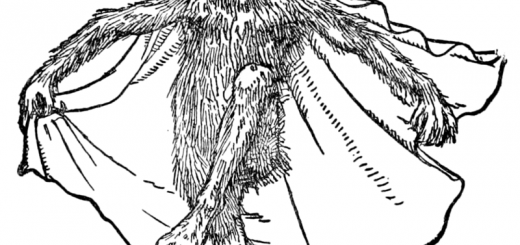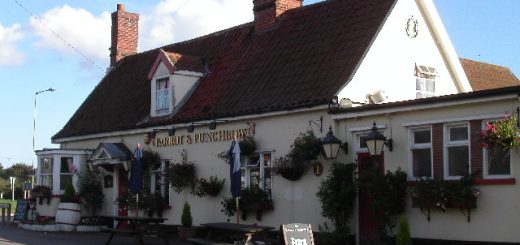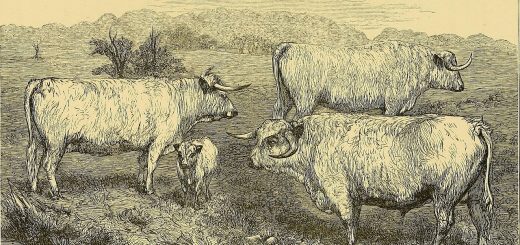Ffynnon Tegla (St Tegla’s Well)
Ffynnon Tegla, (or St Tegla’s or St Tecla’s Well) can be found on private land* near the River Alyn in Llandegla (Llandegla-yn-Iâl). Saint Thecla (Tecla) of Iconium was renowned for curing epilepsy and this is reflected in the healing powers associated with the well bearing her name in Llandegla, though here epilepsy was sometimes referred to as ‘Clwyf Tegla’ (St Tecla’s disease).
 The following folktale entitled ‘The Power of St. Tegla’s Well’ appeared in ‘The Welsh Fairy Book’ (1908) by W. Jenkyn Thomas ‘AT the farm of Amnodd Bwll, at the foot of the Little Arenig, there once lived a farmer called Robert Wiliam, his wife Mari Tomos (in those days a woman did not lose her maiden name when she got married; that is only a recent fashion in Wales), and their only child, a boy who was known as Wiliam Robert (a son took his father’s surname then as his Christian name). Now Wiliam was subject to fits, and in the summer when he attained the age of twelve his father and mother became terribly anxious about him, because so many signs of death followed one after another. One of the apple trees in the garden burst into blossom long before its time, which is very unlucky. The old cock which had for years behaved as well as any chanticleer in the county took to crowing in the middle of the night, and had to have his head chopped of before he would give up the fatal habit. Mari Tomos dreamed that she was at a wedding, which of course meant that she would before long attend a funeral. One night a bird flapped its wings against the window of the room in which Robert Wiliam and Mari Tomos slept, and the hearts of the worthy couple sank at the thought that it might have been the Corpse Bird, that weird, featherless bird, with wings of some leathery substance like those of a bat, which occasionally comes from the land of Illusion and Phantasy to beat its wings against the windows of houses which the King of Terrors is about to visit. Another night Robert Wiliam was so frightened that it was hours after his usual time when he crawled home, shaking like an aspen leaf. He was walking home by himself from a fair at Bala, by the side of the river Tryweryn, when he saw in the fading light a repulsive hag, clad in a long black gown trailing on the ground. Her face was deathly pale, with high cheek bones and deep-sunk lack-lustre eyes; she had great black projecting teeth, and a short nose with widely-distended nostrils. Her hair was grey and tangled. Her arms were skinny and shrivelled and of great length, out of all proportion to her body. She splashed in the water of the river with her hands, and made a most doleful noise. Robert Wiliam at first could not make out any words, but presently he distinctly heard, “My child, my child, my dear son,” after uttering which words the hideous apparition vanished. The thought that he had seen the dreaded Cyhiraeth, and that her cry foreboded the death of his beloved boy, froze the blood in his veins, and the darkness had closed in before he could proceed on his homeward journey.
The following folktale entitled ‘The Power of St. Tegla’s Well’ appeared in ‘The Welsh Fairy Book’ (1908) by W. Jenkyn Thomas ‘AT the farm of Amnodd Bwll, at the foot of the Little Arenig, there once lived a farmer called Robert Wiliam, his wife Mari Tomos (in those days a woman did not lose her maiden name when she got married; that is only a recent fashion in Wales), and their only child, a boy who was known as Wiliam Robert (a son took his father’s surname then as his Christian name). Now Wiliam was subject to fits, and in the summer when he attained the age of twelve his father and mother became terribly anxious about him, because so many signs of death followed one after another. One of the apple trees in the garden burst into blossom long before its time, which is very unlucky. The old cock which had for years behaved as well as any chanticleer in the county took to crowing in the middle of the night, and had to have his head chopped of before he would give up the fatal habit. Mari Tomos dreamed that she was at a wedding, which of course meant that she would before long attend a funeral. One night a bird flapped its wings against the window of the room in which Robert Wiliam and Mari Tomos slept, and the hearts of the worthy couple sank at the thought that it might have been the Corpse Bird, that weird, featherless bird, with wings of some leathery substance like those of a bat, which occasionally comes from the land of Illusion and Phantasy to beat its wings against the windows of houses which the King of Terrors is about to visit. Another night Robert Wiliam was so frightened that it was hours after his usual time when he crawled home, shaking like an aspen leaf. He was walking home by himself from a fair at Bala, by the side of the river Tryweryn, when he saw in the fading light a repulsive hag, clad in a long black gown trailing on the ground. Her face was deathly pale, with high cheek bones and deep-sunk lack-lustre eyes; she had great black projecting teeth, and a short nose with widely-distended nostrils. Her hair was grey and tangled. Her arms were skinny and shrivelled and of great length, out of all proportion to her body. She splashed in the water of the river with her hands, and made a most doleful noise. Robert Wiliam at first could not make out any words, but presently he distinctly heard, “My child, my child, my dear son,” after uttering which words the hideous apparition vanished. The thought that he had seen the dreaded Cyhiraeth, and that her cry foreboded the death of his beloved boy, froze the blood in his veins, and the darkness had closed in before he could proceed on his homeward journey.
He had not gone much further when he saw a corpse candle moving before him along the road. It burned with a red flame, from which it was clear that it was not a woman who was doomed (a woman’s candle is white), and the candle was small, indicating that a child was to die, for the size of corpse candles varies with the age of those whose death they foretell. This succession of nightly horrors almost paralysed Robert Wiliam, and he reached home more dead than alive.
The next day he went to consult a wise man who lived in Trawsfynydd, to see if there was any hope for his son. The wise man told him that his only chance was to take the boy to St. Tegla’s Well, in Denbighshire, and instructed him what to do. Robert Wiliam took his son to Llandegla, and the following ceremony was performed. The boy went to the well after sunset, carrying a cock in a basket. First of all he walked round the well thrice, reciting the Lord’s Prayer. Then he walked thrice round the church, again repeating the Paternoster. After this he entered the church, crept under the altar, and slept there until break of day, making the Bible his pillow and the communion cloth his coverlet. In the morning he placed sixpence on the altar, and leaving the cock in the church departed home with his father. Great was then the anxiety of Robert Wiliam to know the fate of the bird, for if it did not die in the church there would be no hope of cure. In about a week a messenger came to say that the bird had died, and that consequently the disease which had been transferred to it had died also. Whether this was so or not, it is curious that in spite of the apple tree which bloomed before its time, night-crowing cock, Corpse Bird, Cyhiraeth, and corpse candle, Wiliam Robert completely recovered from his illness and lived to a ripe old age.
As in the folktale above there is said to be a set ritual that needed to be undertaken to ensure the cure worked. Francis Jones in his ‘ The Holy Wells of Wales’ (1954) described the steps: 1) Visit the well on a Friday after sunset. 2) Wash the hands and feet in the well. 3) Walk around the well three times repeating the lord’s prayer and carrying a cockerel in a hand basket. 4) Prick the cock with a pin, which is then thrown into the well. 5) Give a groat at the well to the parish clerk. 6) Then walk around the parish church three times with the cock, again repeating the Lords prayer. 7) Enter the church and place another groat in the poor box. 8) Lie under the communion table, with the Bible as a pillow until daybreak. 9) Place the cock’s beak in the mouth and blow, before letting the bird go. 10) Put a piece of silver in the poor box and leave the church. The cocks subsequent death would confirm that the disease had been transferred to the bird and the cure successful.
We are told the following in British Goblins (1881) by Wirt Sykes; ’Only second in fame to Winifred’s, among the Welsh themselves, is St. Tecla’s well, or Ffynon Tegla, in Denbighshire. It springs out of a bog called Gwern Degla, about two hundred yards from the parish church of Llandegla. It is there suggested that the cock to which the fits are transferred by the patient at the well is a substitute for the scapegoat of the Jews. The parish clerk of Llandegla in 1855 said that an old man of his acquaintance ‘ remembered quite well seeing the birds staggering about from the effects of the fits ‘ which had been transferred to them.’
The most recent record of a cure my be from 1813 but Sykes goes on to say that ‘it was asserted by a writer in the ‘ Archaeologia Cambrensis’ in 1856 that money was still thrown into St, Tecla’s well, by persons desirous of recovering from fits.’
*Ask permission at Mill Farm before visiting the well.
Note: No cockerels were harmed in the writing of this article. It has been suggested that for female patients a hen should be used. Mysteriousbritain of course does not endorse this cure.




Re: Ffynon Tegla (St Tegla’s Well)
It is generally thought that Tegla is a Welsh form of Tecla, but could the two be separate people? Tristan Gray Hulse in an article entitled ‘Wells in Depth’ says ‘The identity of the Welsh saint Tegla was so far forgotten at Llandegla by the high middle ages that she was apparently identified, at least liturgically, with the possibly apocryphal but certainly far more famous first-century saint Thecla of Iconium (that a dark age Welsh woman should bear her name is testimony to the early and widespread nature of her cultus). Thecla was renowned for the cure of epilepsy, among other illnesses, and birds of all sorts were offered at her sanctuary at Seleucia, where they lived out their lives in a kind of sacred aviary, in association with the practice of sacred incubation and the cultic use of her holy well. The Seleucian cult was fully articulated centuries before the time of St Tegla; and even assuming an undemonstrable occurrence of fowl-offerings at Llandegla in the pre-Reformation period, and noticing that Celtic Christians had received the cult of saints from the older Churches already fully formed, it is inherently more probable that the Llandegla cult was modelled, either deliberately or unconsciously, upon the antecedent cult of the Seleucian saint, than that it represents a survival of Classical paganism in a North Wales which exhibits singularly little evidence of any such.’